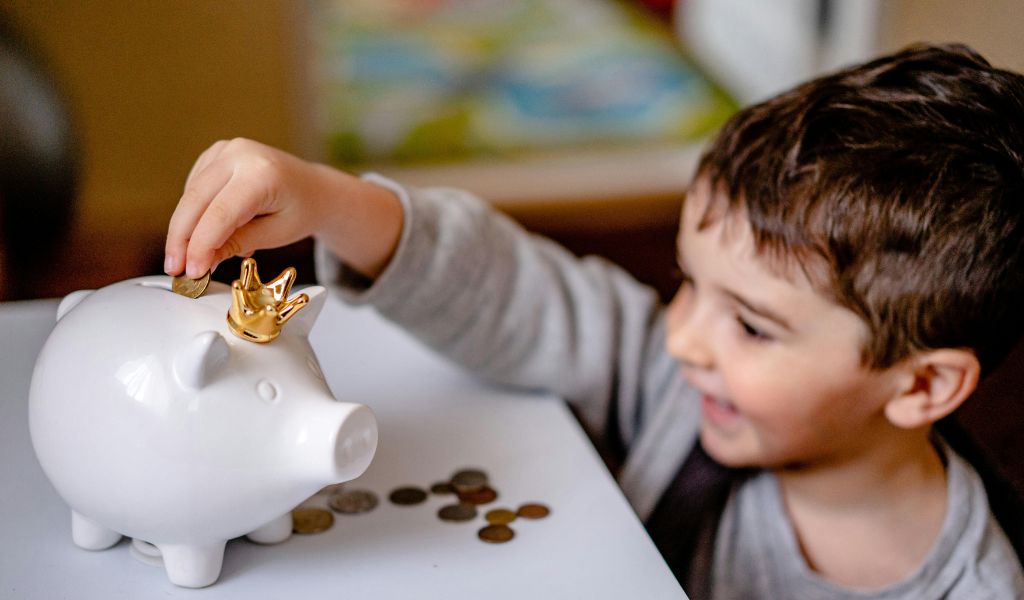Teaching Financial Literacy to Kids: Fun Ways to Raise Money-Savvy Children
6 Mins Read
Published on: 20 August 2025
Last Updated on: 26 August 2025

- Begin With The Basics: Pocket Money With Purpose
- Turn Shopping Trips Into Learning Experiences
- 1. For Younger Children:
- 2. For Older Children:
- Embrace Technology And Games
- 1. Game Apps
- 2. Board Games
- 3. Positive Role Play
- Set Real-Life Savings Goals
- Lead By Example
- How Financial Literacy Prepares Your Kid For Business?
- Why These Small Lessons Matter?
Getting kids to be concerned about money… sure thing, yeah. Most would rather talk about cartoons, the latest toy, or what was stored in the pantry to eat.
Here’s the trick: teaching financial literacy to kids does not always have to be a boring lecture using charts or some discussion regarding “interest rates.”
If you make it enjoyable, if it seems connected to their little world, it actually gets remembered. And those tiny routines? They’ll carry them over into adulthood business—whether they realize it or not.
Money is one of those skills no one ever forgets once the switch has flipped. So the earlier you can start building foundations of teaching financial literacy to kids, the better. Let’s get practical.
Begin With The Basics: Pocket Money With Purpose
To the typical family, pocket money (or allowance) is the initial exposure to money. Rather than making it a mini paycheck which magically materializes in your hand every Saturday, make it an educational experience.
Connect it to effort. Connect allowance to age-appropriate chores—making the bed, putting out the table, doing the laundry. Doing this, money doesn’t just appear from “free paper” from mom or dad but from responsibility.
Introduce the three-jar hack. Use three transparent jars and label them Spend, Save, Share, while teaching financial literacy to kids.
- Spend: For the impulse purchases—treats, stickers, or the occasional toy.
- Save: For the expensive wish item, such as a game or a bike.
- Share: For sharing—donating to charity, helping a friend, or purchasing a treat for a sibling.
This low-key system does more than just teach business budgeting. It teaches values: instant gratification, long-term thinking, and charity. And because it’s hands-on—coins clinking into jars—it’s so much more concrete for little kids than pixels on a screen.
Tip: Later, when children are a little older, you can replace the jars with electronic means (such as a teenager’s checking account) to reflect the world at large.
Turn Shopping Trips Into Learning Experiences
Your weekend shopping trip is not a drudgery—make the shopping list a money classroom in disguise, when teaching financial literacy to kids.
1. For Younger Children:
Make it a scavenger hunt. Ask them to find the cheapest breakfast cereal, compare two brands of bread, or pick items with sale stickers. It’s a game, as far as they are concerned. To you, it’s a price comparison, bargains, and making smart choices lesson.
2. For Older Children:
Offer them an allowance of a few dollars and a mini shopping list—i.e., what they will need for school lunches this week. Observe how they examine sizes, compare prices, and begin to consider “want vs. need.”
That’s not just learning math, that’s learning trade-offs. Do you pay more upfront and save in the long term with the larger pack, or the smaller pack to keep costs today low? That’s a real-life choice adults make every day.
Pro tip: Make them have “mistakes.” If they spend the budget on chips and dips, they’ll quickly realize that there’s not enough money for necessities. Ouch. Better to learn on school lunch than down the road with rent.
Embrace Technology And Games
Kids these days live technology—it’s second nature. So rather than battling it, harness it.
1. Game Apps
There are so many apps for kids that make managing money a game. They allow children to save targets, monitor progress, and even play with bank accounts in a secure setting. To them, it’s playing the next level of a game. To you, it’s instilling saving habit without whining.
2. Board Games
Monopoly, The Game of Life, or even plain play-money cash registers for the kids—these are not merely rainy-day activities. These sow seeds in terms of earning, spending, and consequences. Sure, Monopoly hotels don’t exist, but the idea that poor decision-making results in “bankruptcy” lingers.”
3. Positive Role Play
Young children adore “make believe.” Positive role play helps children practice critical social skills. Create a small shop in the house where they “sell” toys, goodies, or even homemade art work. Provide coins or play money, and bingo. Now they’re making transactions, calculating change, and learning that something costs money.
Tip: Begin with bills and coins and then with apps. Hard money is easier for children to relate to in the beginning. After they learn the fundamentals, you might transition to apps.
Set Real-Life Savings Goals
Saving’s not cool—unless it’s attached to something kids want pretty badly.
- Make a goal together: Perhaps it’s a toy, a new game, or a day out as a family. Engage them in finding the cost. Then calculate: “If you put aside $5 each week, you’ll have that in two months.”
- Make it visible: Place coins in a jar, a sticker chart, or a thermometer-style visualizer they colour in as they save. Seeing progress keeps them going.
- Mark milestones: Don’t wait until the end. Mark midpoints with rewards (like more playtime). This builds momentum and keeps them interested.
Pro tip: Teach delayed gratification. When they’d like to tap into savings for a smaller purchase, remind them of their end goal. The wait—and the eventual reward—is more effective teaching patience than any words could be.
Lead By Example
This is your secret: children observe everything. Children learn much more from what you do than what you say.
- Be transparent: Discuss small money choices aloud: why you prefer one over the other brand, why you wait for something to be on sale, or how you save for family goals.
- Practice using real family situations: If you’re putting money away for a vacation, demonstrate how you put money away for it. If you’re paying off debt, explain simply why you’re doing this.
- Practice generosity: Demonstrate how you give back—whether it’s donating, tipping freely, or lending someone money who is down on their luck. Children know that money is not only for keeping but for giving.
- Let them fail: Don’t bail them out every time. If they spend all foster carers allowance at one time, make them experience the frustration of having nothing left. That pinch will teach more than any lecture or sermon ever can.
Pro tip: Have age-appropriate family money discussions with them. Even something as minor as deciding between two activities for the weekend (and talking about the cost difference) teaches.
How Financial Literacy Prepares Your Kid For Business?
Giving your kid early financial literacy knowledge helps to mold their mind towards running a business from an early stage. But what can you do towards that?
- Help them set-up kid-friendly businesses like bake sales, lemonade stands or selling certain homemade stuff. And make the experience fun for them.
- Explain them how these little ventures are profitable for them, and teach them about profit, cost, reinvestment and customer service.
Why These Small Lessons Matter?
In the end, it’s not to turn your 8-year-old into a money manager. It’s to teach them habits, values, and awareness that grow with them while teaching financial literacy to kids.
- They know money is earned.
- They get better at making choices between needs and wants.
- They get better at saving, giving, and spending in balance.
- They gain confidence to make larger money decisions down the road.
And the trick is: keep it light and fun. Games, jars, goofy money challenge at the store—these little money lessons stick in our heads longer than we ever realized.
Because when those kids are adults, those lessons from childhood determine how they manage paychecks, credit cards, and investments, too.
That is to say: a little money fun today creates money confidence for a lifetime.
Would you prefer me to break this out into a guide by age group (e.g., preschoolers, primary children, teenagers), or as one general piece for parents in total?



















Comments Are Closed For This Article